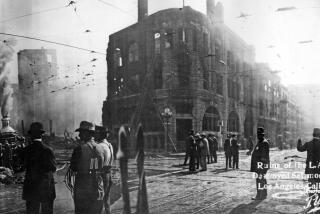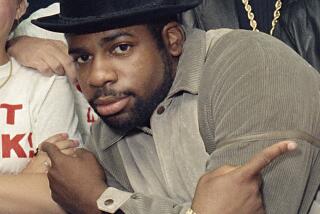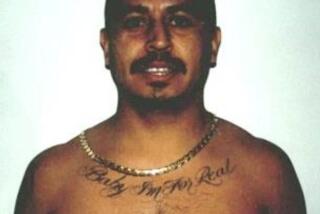McVeigh Case Hinges on the Circumstantial
DENVER — Two years in prison have not changed the man.
Timothy James McVeigh is still the thin, serious, pale-skinned figure the nation first glimpsed on the day of his arrest, escorted out of an Oklahoma courthouse in waistcuffs and leg irons, damned by a jeering mob as the worst mass murderer in the nation’s history.
He still greets a visitor with a look from cold blue eyes, still proclaims his innocence, still demands a jury trial.
Yet this morning, when at last McVeigh goes on trial, there is one difference from two years ago: The case against him does not seem nearly as solid as it once did.
Can prosecutors, in fact, prove that this decorated Army veteran of the Persian Gulf War acted alone in driving a bomb-laden, yellow Ryder rental truck up to the circular drive outside the Alfred P. Murrah Federal Building in Oklahoma City at 9:02 a.m. on April 19, 1995?
The government still cannot place the 28-year-old defendant at the site of the explosion that killed 168 women, children and men and injured 500 others. It cannot place in his hands the ammonium nitrate used in the bomb. It also has no confession, despite the leak of several reported McVeigh “confessions” that have tumbled into media accounts in recent weeks.
What prosecutors do have is a case that rests largely on circumstantial evidence.
Witnesses have identified McVeigh as the nervous customer renting the truck two days before the bombing. His jeans and T-shirt, knife and earplugs, reportedly were covered with forensic evidence matching chemical components found inside the truck. And he had ranted for years against perceived government abuses, especially the failed 1993 FBI raid in Waco, Texas.
But his defense lawyers have woven a pattern of doubt into the government’s case.
They have highlighted widespread problems of contamination at the once-famed FBI crime lab, where McVeigh’s clothing was examined. They have conjured up conspiracy theories indicating others may have had a larger role in the bombing. They have hinted about foreign terrorist cells operating in the Philippines and Europe.
And the defense lawyers hold a wild card--the FBI mug shot of John Doe No. 2, the elusive second suspect. Federal authorities say they now believe that McVeigh had no such companion, but the defense will argue that change of heart is simply an attempt to snip off a loose end that could tangle the prosecution’s case.
His lawyers hope to use those elements of doubt to convince jurors that McVeigh is not guilty--or to let him live if there is evidence that co-conspirators were permitted to go free.
This morning, hundreds of residents of the Denver area and eastern Colorado are to converge in the second-floor courtroom of U.S. District Judge Richard P. Matsch for the start of jury selection.
*
The date--April 19--is Patriots Day. It is the date commemorated for the shots in Massachusetts--at Lexington and Concord--that opened the Revolutionary War in 1775. In 1993, it was the day that a failed FBI tank movement at Waco, Texas, ended in the deaths of more than 80 Branch Davidians. In 1995, that date marked the worst terrorist attack in U.S. history.
But this wasn’t the sort of terrorism many Americans expected. If you believe the government, it didn’t come from outside the nation. It was, instead, the work of a scrawny kid from upstate New York, the son of a good Catholic man in the small community of Pendleton, where the great local pursuits are as American as bingo and bowling.
McVeigh made it through high school but checked out of business college. He turned instead to the Army. It was there he found glory as a decorated tank gunner in the Iraqi desert.
Later, in his years after rejection from the Army’s elite Special Forces led him to quit the service, he wandered the washboard of America, traveling throughout the Midwest, working gun shows and showing up at right-wing expositions where the watchword of “patriots” is, always, vigilance.
He worried that a “New World Order” would make the United States submit to a larger authority. He opposed U.S. soldiers fighting under a United Nations flag. He believed that black government helicopters spy on Americans in the night. During the FBI siege of the Branch Davidians at Waco, he turned up outside the compound, selling bumper stickers that complained about the Bureau of Alcohol, Tobacco and Firearms and warned of unreasonable gun control.
Prosecutors in Denver will say he could not control his hatred after what happened at Waco. They will argue that Waco was the catalyst--his spark, his trigger. Oklahoma City was his revenge.
Their critical pieces of evidence:
* A dealer at the Mid-Kansas Co-Op in McPherson, Kan., believes that it was McVeigh and co-defendant Terry L. Nichols--who will be tried separately--who purchased large bags of ammonium nitrate in the fall of 1994.
* Fingerprints on a sales receipt for ammonium nitrate that match McVeigh’s.
* Two employees at the Ryder agency in Junction City, Kan., who swear that McVeigh rented the truck two days before the bombing.
* A service station attendant in Billings, Okla., just across the Kansas state line, who remembers McVeigh pulling in shortly after midnight on the morning of April 19. He will say McVeigh was headed south, in the direction of Oklahoma City.
* Debris found in FBI crime laboratory examinations of McVeigh’s clothing, knife and earplugs matching that from materials found on a piece of board from the inside of the truck.
But is that enough to convict McVeigh? Is that enough to put a man to death?
The government also has compiled a string of letters he wrote to a friend in New York during his years wandering the country, letters in which he vented anger against the government and insisted that something must be done to take back America.
There are similar letters and phone calls and conversations with his sister, Jennifer McVeigh, expected to be a key government witness--albeit a hostile one.
The government also has found other people, on the gun-show circuit, in the Army, in McVeigh’s old neighborhood in Pendleton, who also could help the jury delve into his mind and his intense hatred for the government.
But most important, there is the prosecution’s own secret arsenal--Michael and Lori Fortier of Kingman, Ariz.
Michael Fortier is a former Army buddy of both McVeigh and Nichols, a longtime McVeigh chum when they lived together in the desert Southwest. Prosecutors say he will testify that McVeigh let him in on his plans to destroy the Murrah building. His wife will describe how McVeigh arranged soup cans in their house to show how large barrels are assembled to make a truck bomb.
The Fortiers are the government’s star witnesses. McVeigh once lived with them in their Kingman trailer home. He slept on their couch. He was the best man at their wedding.
Now, they are his Brutus.
*
McVeigh’s defense attorneys are happy to start with the Fortiers.
They call them liars.
Michael at first insisted to authorities that his friend could not have done such a terrible crime. Lori agreed. Not Tim, they said.
But later, faced with their own criminal culpability, the Fortiers crumbled.
Michael ultimately pleaded guilty to charges of knowing about the bombing but doing nothing to stop it. He received a 23-year prison term, with the promise of reduced time if his testimony would help nail McVeigh and Nichols. As part of the deal, Lori, who also must testify, was permitted to go free.
Even if the Fortiers don’t testify as prosecutors expect, that alone will not absolve McVeigh.
So, defense attorneys have attacked the government’s physical evidence. They have raised sharp allegations of widespread contamination problems at the FBI’s crime laboratory, pointed to the FBI’s decision to remove several key chemists from the lab and insisted that some FBI lab technicians have had a history of falsifying reports or committing perjury to further the goals of prosecutors.
His lawyers also claim there was a wider conspiracy. They have raised concerns about a far-right, religious compound called Elohim City in eastern Oklahoma. They have suggested a link to neo-Nazi organizers in Germany. They have indicated that the road to Oklahoma City actually may have begun in the far Pacific--perhaps in the Philippines, where Nichols often visited.
In making these arguments, they have suggested that McVeigh was nothing more than a patsy, a dupe, that others unknown to him set him up to take the fall. They hint that McVeigh was told to drive the truck and leave it at the Murrah building, believing it was filled with something other than 4,800 pounds of ammonium nitrate and fuel oil sloshing around in 55-gallon drums.
The McVeigh defense team can use that analogy--perhaps effectively--because of the existence of one mystery figure: John Doe No. 2.
That figure--square jaw, dark eyes, tattoo--is the second man employees at the Ryder rental agency said accompanied McVeigh when he picked up the truck. The government has contorted itself in its attempts to make him go away, saying he was mistaken for an Army soldier at Ft. Riley, Kan., and then later that he never existed. Nevertheless, he could raise doubts about whether McVeigh was indeed a central player in the bombing.
The blast still reverberates. The United States is slowly adapting to the threat of terrorism. So much has filled the calendar in the last two years.
The crash last summer of TWA Flight 800--a bomb, a missile, mechanical failure? The bombing three days later at the Summer Olympics in Atlanta also remains unsolved.
With Oklahoma City, a sudden harsh light was shined on paramilitary, anti-government groups. But that only has led to a sharper increase in the number of militias and their members.
In Washington, anti-terrorism legislation has been enacted to curb hate crimes. Barricades have been placed strategically in front of federal buildings. Even Pennsylvania Avenue in front of the White House has been closed to traffic.
But still targets are being hit: abortion clinics in Atlanta and Tulsa, Okla., and a lesbian nightclub in Atlanta.
Senior federal law enforcement officials, seeking ever-more police muscle such as roving wiretaps, predict that Oklahoma City can happen again. But they also acknowledge that so much depends on the outcome in Denver, on how the jury views McVeigh, on whether they send him home to his family or off to join 11 other men on federal death rows.
Regardless of where his fate lies, McVeigh long has yearned for this trial. For two years, he has worked closely with his lawyers, reviewed tens of thousands of FBI interview reports, evidence logs and other documents.
Housed first in a federal prison in El Reno, Okla., and now in a federal installation in the Denver area, McVeigh seems to have adjusted well to the strictures of prison life. He exercises little and reads voraciously, everything from Einstein’s theories to Zane Grey. Asked in a prison interview what he misses most about losing his freedom, he pauses. Then, he says, “Trees.”
He does not hide his hatred for what the government did at Waco. He was asked what he would do to resolve a kidnapping crisis then underway in Bosnia.
He answered with a broad grin.
“Send in the FBI SWAT team,” he said. “They’re good at killing women and children.”
(BEGIN TEXT OF INFOBOX / INFOGRAPHIC)
On Trial: Timothy McVeigh
Age: 28
Hometown: Pendleton, N.Y.
Background: Single; Army veteran decorated in the Persian Gulf War.
The charges: Has pleaded not guilty to an 11-count federal grand jury indictment in the Oklahoma City bombing. Accusations include conspiracy to use a weapon of mass destruction, use of a weapon of mass destruction, destruction by explosive and first-degree murder in the deaths of eight federal law enforcement officers.
Co-defendant: Terry L. Nichols, 41, of Herington, Kan. Will stand trial after McVeigh.
More to Read
Sign up for Essential California
The most important California stories and recommendations in your inbox every morning.
You may occasionally receive promotional content from the Los Angeles Times.











